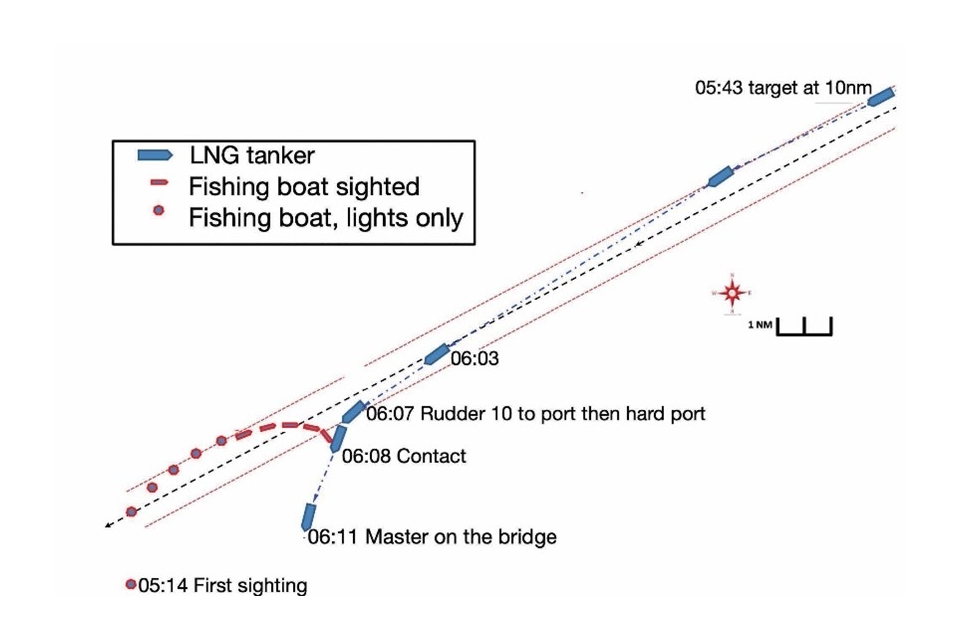Use all available means to determine if risk of collision exists. The Nautical Institute gives this advice in its latest Mars Report, in which a collision between an LNG tanker and fishing might well have been avoided.
The Nautical Institute gathers reports of maritime accidents and near-misses. It then publishes these so-called Mars Reports (anonymously) to prevent other accidents from happening. A summary of this incident:
An LNG tanker was proceeding in the open sea at a speed of approximately 21 knots in good visibility. At 05:14 the lookout spotted a light and reported it to the officer of the watch (OOW) as a “fishing boat”, approximately 5 degrees to port. About 22 minutes later, the lookout reported that the fishing boat was right ahead and that he believed that it was close to their vessel.
The OOW used his binoculars to try and estimate the distance of the fishing boat. He believed that it was still quite some distance away. However, the lookout’s assertion that the fishing boat was close raised some doubts in his mind. As a result, the OOW made a small alteration of course to starboard to avoid having the fishing boat right ahead and to clear it visually from the vessel’s vent masts.
Also read: What collisions between commercial and small vessels can teach us
Five minutes later, the lookout reported the fishing boat ahead once more and suggested to the OOW that it was now crossing from port to starboard. The OOW determined visually that the fishing boat was indeed crossing from port to starboard and made a two-degree alteration of course to port to put it fine on the starboard bow. A few minutes later, the OOW again altered course to port a few degrees to a new course of 239°.
The fishing boat now appeared on the radar right ahead and was acquired. It was 7.6 nm away, making a speed of 5.5 knots. Soon, clearer visual contact was made with the fishing boat and both the OOW and the lookout observed green and red navigation lights. The OOW started giving light signals to the fishing boat using the bridge Morse light as per the collision regulations.
At 06:03, the fishing boat now only 1.7 nm away, was seen to alter course further to starboard showing only its red light. The OOW deemed this to be an attempt by the fishing boat to cross ahead of them.
Finally, the OOW ordered hand steering engaged and ordered 10 degrees to port and then hard port. Shortly after, the fishing boat disappeared from view from the conning position.
The OOW went out onto the starboard bridge wing and observed the fishing boat in contact with their vessel mid-ships. He ordered the helm hard to starboard to help move the stern away from the fishing boat. The fishing boat’s port bow came in contact again in way of the tanker’s starboard engine room water ballast tank and then cleared. The OOW called the master, and it was confirmed that the fishing boat was intact, and the crew were not injured.
Also read: Another collision in daylight and good visibility
Advice from The Nautical Institute
- The OOW did not use all available means to determine if risk of collision existed. For example, he did not take compass bearings of the light when it was first reported to port and as the range decreased.
- At a critical decisional moment, with the fishing vessel 7.6 nm away and clearly on a reciprocal course the OOW decided to alter course to port – but only by a few degrees. With a closing speed of about 26 knots this meant the vessels would meet in about 3.5 minutes. Now was the time for an alteration to starboard large enough to be readily apparent to the fishing vessel.
- Hand steering was not engaged until virtually the very last moments before contact. Given the situation and the levels of risk, it would have been more appropriate to do so much earlier.
Mars editor’s note
This incident brings to mind an excellent edition of ALERT! (issue No.16) from some years back. In one of the articles, we read that ‘experimental studies show a strong bias to take avoiding action late in the chain of events, rather than early. This seems to be a hard-wired approach to danger. It is only with considerable experience including near misses and accidents, that avoidance action is taken earlier in the chain of events.’
Readers are invited to review the entire publication here.
Also read: Cargo vessel ignores collision with fishing vessel
Mars Reports
This accident was covered in the Mars Reports, originally published as Mars 202358, that are part of Report Number 374. A selection of the Mars Reports are also published in the SWZ|Maritime magazine. The Nautical Institute compiles these reports to help prevent maritime accidents. That is why they are also published (in full) on SWZ|Maritime’s website.
More reports are needed to keep the scheme interesting and informative. All reports are read only by the Mars coordinator and are treated in the strictest confidence. To submit a report, please use the Mars report form.








